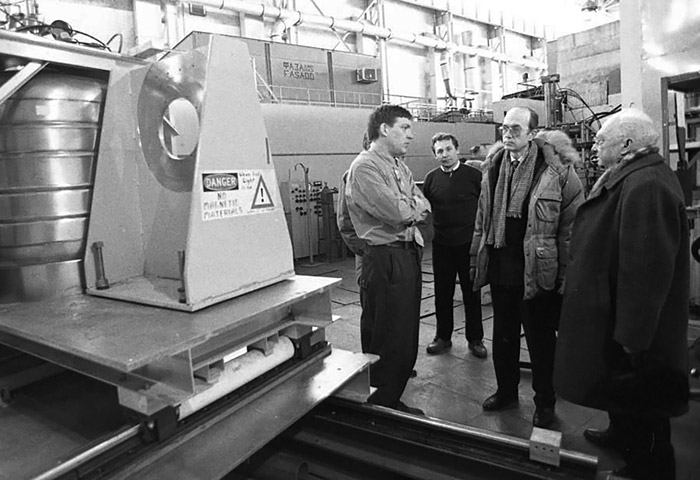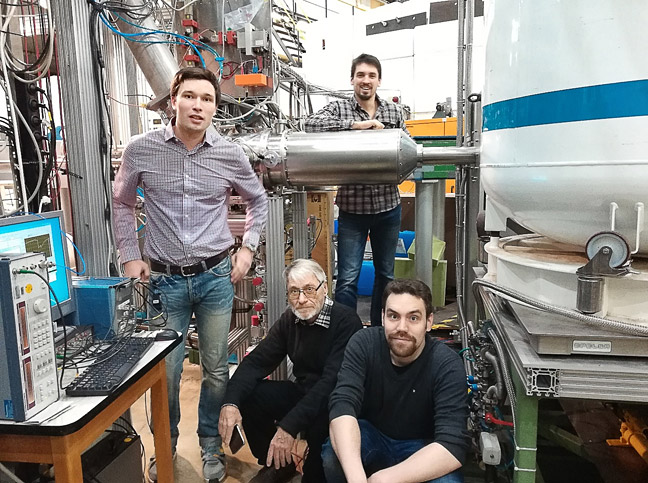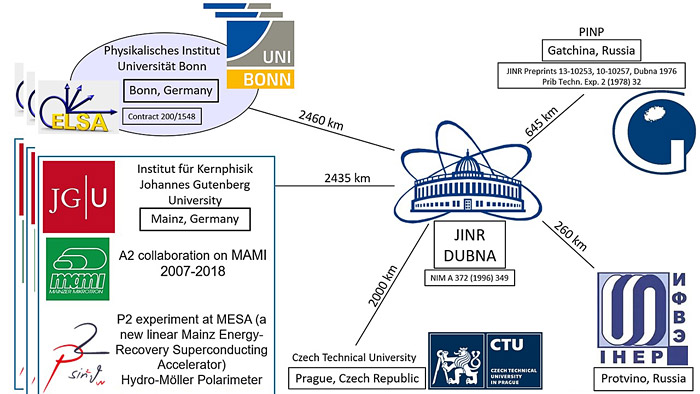
Electronic english version since 2022 |
The newspaper was founded in November 1957
| |
|
Number 20 (4668) |
The team and its work
Ultralow temperatures in spin physics
From the history of a sector
End of story. Beginning in No.19
Here it is worthwhile to mention another serious work done by the SLT researchers in 1994–1996. In December 1993, a message came from INTAS to notify about a financial support (60000 ECU) of our project «Upgrading of the movable polarized target (MPT)». Participants in the project were specialists from France, Ukraine, and Russia (INR, PINP, JINR LHE) with the leading role of the LNP SLT researchers
The work was divided into two stages. The first stage started in 1994 with assembling and full commissioning of the MPT under the laboratory conditions at the LNP site. This stage was successfully completed on 14 December 1994, that is, just a day before the deadline.
In 1995, the Plenipotentiary of the Russian Federation at JINR B. G. Saltykov and the JINR Directorate visited the constructed facility and expressed support for the reported activities and JINR as a whole.

Left to right: Gilles Durand (Saclay, France), Yu.A.Usov (LNP, JINR),
B.G.Saltykov (Vice-Premier, Minister of Science and Education,
Plenipotentiary of RF at JINR),
and A.M.Baldin (Academician, Director of LHE, JINR), 1995
The second stage was associated with the second grant received from INTAS in 1995 for polarization investigations with the MPT using the neutron beam of the Synchrophasotron at the Laboratory of High Energies, JINR. The investigations were also successfully performed, of which a documentary was made and later shown by the French TV channel TF5.
It is worth noting that those investigations were carried out in the hard after-reform time and that it was the first time that JINR received a grant like this.
In 1999–2001, the researchers of the Sector also took an active part in the development of the ATLAS liquid-argon calorimeter at CERN. At that period a necessity arose to calibrate platinum thermistors for precision temperature measurement of facility elements immersed in liquid argon. Scientists from JINR (LNP and LHE) prepared and signed a contract with CERN on precision calibration of 1800 platinum thermistors, which was done in compliance with the relevant plans. Most of these calibrated thermistors were mounted by the JINR specialists directly on the ATLAS detectors.
A particular story is collaboration with the University of Mainz and the University of Bonn. It began as far back as 2003, when the LNP SLT scientists got occupied with development and construction of a polarized target cryostat under the agreement with the University of Mainz. Since the cryostat was a key element dictating the main parameters of these experimental facilities, development and construction of the cryostat was a serious methodological problem which the SLT specialists successfully solved by the end of 2007. Later, at various international specialized conferences, such as PSTP (Polarized Sources, Targets and Polarimetry), experts acknowledged it to be the world’s best polarized target!
A specific feature of the physics research performed with this polarized target in Mainz was the use of ideas earlier put forward by S. B. Gerasimov from the Laboratory of Theoretical Physics (LTF), JINR. This polarized target on the MAMI C accelerator of the University of Mainz was successfully employed by a large international collaboration A2 until 2015.
At approximately the same time, the question came up before the University of Bonn as to the shutdown of its ELSA accelerator, since polarization investigations, dominant for that machine, had not been carried out there for more than ten years. It turned out that for some reasons they could not develop a new cryostat for the experimental facility over a long time (some 15 years). In view of this, the SLT specialists proposed to not simply transfer the polarized target from Mainz to Bonn for implementing the experimental program delayed for many years, as was initially intended, but to make a new cryostat in Dubna for the University of Bonn.
It took about four years of determined effort by specialists not only from LNP but also from other departments of JINR to manufacture a 3He–4He dilution refrigerator for the new polarized target to be used in joint experiments at the accelerator of the University of Bonn.
The upgraded Crystal Barrel facility on the ELSA accelerator at the University of Bonn allows measuring double polarization observables for reactions of neutral meson photoproduction. It is these measurements that are crucial for searching for «missing» resonances in investigations of meson and hyperon production on protons. In June-July 2021, SLT specialists carried out final tests of the new cryostat in Bonn together with the last beam run at ELSA.
Now about the main and new among our scientific activities: the SLT researchers currently participate in development of the precision Moller polarimeter for MESA, the new superconducting accelerator of polarized electrons at the University of Mainz. There will have to face highly sophisticated problems of precision measurement of the electron beam polarization. The main part of this polarimeter is a powerful 3He/4He dilution refrigerator, and this is just the area of the SLT’s unique experience and best methodological practices. A team of experts from the Laboratory of High-Energy Physics (former Laboratory of High Energies) led by V. V. Fimushkin is also engaged in the development of the polarimeter for MESA.

Launching the facility at ELSA: A.S.Dolzhikov, A.B.Neganov, I.S.Gorodnov, and S.Runkel (Bonn)
In conclusion, the following should be said about the fundamental quality of international scientific collaboration. To my mind, Germany is a «key» JINR Member State, and, considering serious mutual obligations involved, the above examples of our (LNP SLT) collaboration with Germany substantially affect relations between JINR and BMBF, the German ministry that actively supports domestic research. Implementation of joint research programs raises the status of JINR as a leading international scientific center.
It is also worthwhile to point out principles of participation of the SLT researchers in international collaboration. Here we follow the ideas of Academician G. N. Flerov. His known opinion about the principles of participation of JINR scientists in outside experiments is that «...participation is only possible if the experiment cannot be conducted without scientists of the Institute...». Indeed, in this case, relationships in an international collaboration are established in an appreciably different way, and the JINR team is not an assistant but a leading and responsible party with all ensuing consequences. We are usually charged with ensuring experimental conditions for investigation of two-spin (beam—target) reactions, most complicated methodologically and most informative physically.

Main ongoing SLT activities.
More information about SLT can be found on the Sector's website at snt.jinr.ru.
Yury USOV, Head of the Sector of Low Temperatures of DLNP